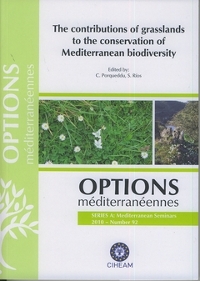| Article précédent | p. i-iv | Article suivant |
Dry matter yield and quality evaluation at different growth stages of triticale forage in South-West of the Iberian Peninsula
The dehesa ecosystem in the south west of the Iberian peninsula has in herbaceous biomass production, the basis of the extensive livestock managment. Nevertheless, due to the erratic climatic conditions that the experiment areas endure, food shortage for the animals takes place in the course of the year. In this paper, the possibility to introduce triticale crop for a double use (by grazing in winter and cut at early and late spring) has been studied. Triticale varieties were, var. Fronteira, var. Alter and two experimental cultivars from the Portuguese National Agricultural Research Institute, called INIA 1 and INIA 2. As reference treatment, a variety of Italian reygrass was used. The experiment was carried out in two different locations of the South-West of the Iberian Peninsula: in Elvas (Portugal) and in Jerez de los Caballeros (Spain), which have different rainfall and temperature ranges. As expected, every trititcale cultivar biomass yield exceeded the reference treatment one. Fronteira variety, even though it did not have the best forage yield, it had a good one; that is important because this triticale variety was the best one as far as forage quality is concerned, measurd by CP, OMD and NDF.
La base de la gestion de l'élevage extensif dans l'écosystème de la dehesa, au sud ouest de la Péninsule Ibérique est la production de biomasse herbacée. Néanmoins, à cause des conditions climatiques erratiques que ces zones subissent, un déficit de nourriture apparaît pour les animaux au long de l'année. Dans cette étude, la possibilité d'introduire la culture du triticale à double utilisation (pâturage hivernal et fauchage à la moitié et à la fin de la saison pour conserver le fourrage) est étudiée. Les cultivars de triticale ont été : var. Fronteira, var. Alter et deux cultivars en expérimentation de l'Institut National de Recherche Agronomique portuguais, appelés INIA 1 et INIA 2. Le ray-grass italien a été utilisé comme culture témoin. L'expérience a été menée à deux endroits différents du sud-ouest de la péninsule ibérique : Elvas (Portugal) et Jerez de los Caballeros (Espagne), à différents niveaux de température et de précipitation. Comme prévu, tous les rendements de cultivars dépassaient le rendement du témoin. Le rendement fourrager de la variété Fronteira n'était pas le meilleur mais il a été acceptable, ce qui est important parce que cette variété avait la meilleure qualité de fourrage par rapport au contenu en protéine brute, en fibre neutre détergent et en digestibilité de la matière organique.
- [ Afficher ]
- [ Télécharger ]
- [ Exporter la citation ]
Vous pouvez télécharger la citation au format :
- [ Imprimer ]
-
Mots-clés
COMPOSITION CHIMIQUE, ELEVAGE EXTENSIF, ESPAGNE, PLANTE FOURRAGERE, TENEUR EN MATIERE SECHE, TRITICOSECALECiter cet article
Rodrigo S., Poblaciones M.J., Pinheiro N., Maças B., Olea L., Santamaría O., García-White T., Coutinho J. Dry matter yield and quality evaluation at different growth stages of triticale forage in South-West of the Iberian Peninsula. In : Porqueddu C. (ed.), Ríos S. (ed.). The contributions of grasslands to the conservation of Mediterranean biodiversity. Zaragoza : CIHEAM / CIBIO / FAO / SEEP, 2010. p. i-iv. (Options Méditerranéennes : Série A. Séminaires Méditerranéens; n. 92). 13. Meeting of the Sub-Network on Mediterranean Forage Resources of the FAO-CIHEAM International Network for the Research and Development of Pasture and Forage Crops, 2010/04/07-10, Alicante (Spain). http://om.ciheam.org/om/pdf/a92/00801257.pdf



